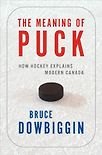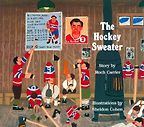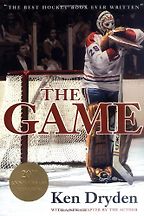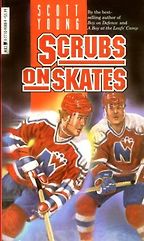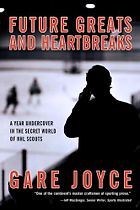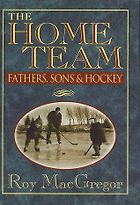Stick and ball games have been around since ancient times. But when, where and how did the stick and the puck get combined with the ice and the skate to make the game of ice hockey we recognise today?
There was a lot of debate about where hockey started, but this generation conceded that it was probably in Nova Scotia or Quebec, and it came out of a marriage of the games that the native Indians played with those that the Irish, English and Scottish brought over. They merged to be a game that you played with a puck on a sheet of ice in wintertime. The rules of the game as we know them probably got codified at McGill University in Montreal. That’s the cradle of the game.
Some argue that it was the introduction of superhuman speed that comes with skates, and with the invention of the Acme spring skate in 1865, that made hockey so exciting to so many. What do you think? What makes ice hockey so enduringly fascinating to its legions of fans?
I think certainly it’s the speed. Early skates took you twice or three times as fast as you could run. Speed makes hockey a dynamic sport. Then you add the physical aspect of it. Many early hockey players also played rugby. Hockey has speed and the physical qualities of games like rugby – I think that really appeals to people. And look, in the heart of winter, especially back in the 19th century when winters were colder and entertainment was harder to come by, people had to amuse themselves doing something. Hockey was one of the most dynamic ways to divert yourself during a long cold winter.
Unlike a sport like American football, the rules of hockey are somewhat simple, right?
The rules make themselves easily understood. There are five a side, you can’t advance into the offensive zone ahead of the puck and there are lots of rules regarding penalties, like in football – but at its most basic, just get the puck past the goalie into that net. For over a century people have been trying to figure out the best ways to do it. There’s a lot of yin and yang to it. Sometimes the offence scores lots of goals, then the coaching catches up and it becomes a defence game. In that way it’s a little bit like football too. But at its most basic, as the hockey expression has it, put the biscuit in the basket.
What else do I need to know to enjoy the game?
Anyone would be able to pick up the basic rules by watching for a period or two. Usually by then you’ve also seen the speed and the excitement that it generates. It’s a pretty compelling spectacle for the first-timer.
The Hockey Sweater, by Quebec writer Roch Carrier, seems like a good place to start. This book is so revered that I read it inspired the illustration on the back of the Canadian five-dollar bill. Please give us a précis of the plot and tell us what makes this 1985 illustrated version of the short story such a children’s classic.
The hockey scene on the five-dollar bill, showing a game in motion outdoors on a frozen pond, gives you a pretty good sense of the kind of picture that Roch Carrier painted of post-war Quebec in The Hockey Sweater. It’s told very simply as well, which is why it’s a book that could be read by children. But adults can get just as much out of it. It’s like The Little Prince by Saint-Exupéry – a very simple tale but it has layers and layers.
The book is about a young boy who lives in a small Quebec town, where they never hear or speak English, whose mother orders him a hockey sweater from a catalogue – Eaton’s catalogue was famous in Canada for most of the 20th century. The mother inadvertently orders the wrong team jersey. In fact, she orders the jersey of the English-speaking team. This young boy has to go out on to the ice in this small Quebec town, where everyone is a fan of the Montreal Canadiens, wearing a Toronto Maple Leafs jersey, and the story is about the life lessons he learns from that experience.
What does The Hockey Sweater teach us about the love of the game and its devoted followers?
The reason the book is revered is that it teaches about not only the game but also its place in Canada, particularly in 1930s Quebec. The passion for the Montreal Canadiens became part of the Nationalist movement that came out of Quebec. A lot of people associate the Nationalist movement with the hockey team. The Canadiens’ success is seen as being a first step towards the Quebec nationalist dream. The book talks about the tensions in our country between English and French, and how putting on a particular hockey sweater could define you and where you were going with your life.
Next is The Game, widely heralded as the best book about hockey. It was first published in 1983 and was named one of the 10 best athletics books of all time by Sports Illustrated. Please introduce us to the book and its author.
The Game may be the best sports book ever written by a participant. It’s by Ken Dryden, who was perhaps the best goalie of his era. He played for the Montreal Canadiens in the 1970s, at the time when they might have been the best hockey team ever. He tells his story in a journal format, tracing not only what was happening on the team but what was happening in the world around him – the sociopolitical atmosphere in the province of Quebec when nationalism was rearing its head.
Ken Dryden is a graduate of Cornell, an educated and erudite observer. But he was also a great athlete. With these books, the person is either a great writer but not really a participant of any value, or else they’re an athletic star but they haven’t got the means to tell the story in a way that resonates. Dryden is an excellent writer and he was an excellent athlete so he was able to write an unsurpassed insider account of the game and point out its place in our culture. I don’t think you can find a better book by a participant in any other sport.
The Game
focuses on the Montreal team, known simply as Les Canadiens. This is the only case I know of a team going simply by the name of their nationality. Dryden went on to become a Canadian MP and once remarked of his fellow Canadians, “When hockey isn’t going well, we Canadians don’t seem to be doing as well, either.” During the 2010 Olympics, more than 80% of the country watched the men’s finals. How central is hockey to the Canadian psyche?
The statistic you just gave speaks to how indelibly hockey is ingrained into the Canadian culture. Baseball is very popular in the United States but there are other sports Americans love. With the exception of maybe soccer in Argentina and rugby in New Zealand, no other country so identifies with a single sport as Canada does with ice hockey. It speaks to our national character. It’s what we send forward into the world.
In your book The Meaning of Puck you use hockey as a window into the Canadian soul. What do you show us?
I tried to unlock the mystery of why Canada and hockey are so inextricably linked. I took the reader back to the 19th century to understand why we became so enamoured of this game and why we’ve adopted it as our own. I looked back at moments in hockey history, like the 1972 eight-game summit showdown between Canada and the USSR. It was Canada’s first chance to beat the Soviets. They beat us in the Olympics, where you were only allowed to use amateurs. In the summit series we used our best players. The entire country was absolutely wrapped up in these eight games against the Soviets. It was a cultural political sport.
I try to identify in the book why it is we have that link to hockey, and in particular why a country that is so well known for being pacifist is so attached to what might be the most violent team sport in the world – the only sport that I know of which allows you to fight and still stay in the game.
What are the answers you came up with?
It has to do with our pacifist character. Human nature isn’t all docile. There are primal urges. Hockey is a chance for us to express or experience vicariously the very opposite of pacifism within a sport. And for a country that had two very strong forming influences, the English and the French, hockey is a way to basically work out that relationship, work out the tensions between the two sides without it erupting into civil war or something worse. Often the conflict in hockey represents and is a way of working out other tensions in our country. If conflict is played out in hockey, then we don’t necessarily have to play it out in other parts of our lives.
Future Greats and Heartbreaks is based on National Magazine Award-winning sportswriter Gare Joyce’s year as a hockey scout. Please tell us about it.
The reason I like this book is that it reminds me of the kind of books I like writing and reading. Gare was able to become a scout, part of the personnel department for an NHL team the Columbus Blue Jackets – a really terrible team. He was able to participate in their scouting and their drafting over the course of the year. In the book he shows people, in a first-hand way, how scouting works and how pro sports work. Gare got to be a participant in this story in a way that few of us authors ever get to be.
It makes for a really interesting and informative read for a hockey fan. Even if you’re not a fan of hockey, if you’re just a sports fan, there’s a lot that you can take from it about how players are evaluated that applies to baseball, football, basketball – to any team sport. It has become so scientific over the last decade and a half. Players are carefully assessed and tested. Hockey, like the other sports, has become a multibillion-dollar enterprise. So much money is riding on each one of these decisions.
What does Future Greats and Heartbreaks tell us about what teams go through to get the best player and what players go through to get picked?
The best lesson is that everyone tries to be scientific and everyone tries to be thorough, but the most important thing is the most unknowable. You need to understand the heart of the player, understand how the player could work within the team. Some general managers draft players and select players and trade for players who don’t necessarily fit with their team culture. I don’t think fans understand how complicated it is to find the right guy, the person who has leadership ability, the player who can fit into a culture the team is trying to build. I don’t think the fans understand, but this book helps you to.
Joyce’s year as a scout seems to have changed his take on the game. How has your ringside view affected your view of hockey?
I’ve known players, and I’ve known people who work in management. When you get close to the sport you get a glimpse of its particular internal culture, which is not unlike the culture of the military or the police. It’s a culture that basically exists for itself, and it runs hockey in its own way, defying outside pressure. Sports in general, and hockey in particular, here in Canada almost have a get-out-of-jail-free card when it comes to how they operate. It’s really quite fascinating to see the hold that professional sport has on everyone, from the average fan right up to the prime minister.
What is unique about hockey’s culture?
What’s interesting about hockey, compared to the other team sports, is that it is intercultural. Obviously there’s the Canadian hockey culture, which dominates or at least tries to dominate. But then we have the culture of the Americans and the Russians and the Czechs and Swedes, who love the sport and who have things to add to it. It’s not dissimilar to what happened to soccer when the English let soccer go out into the world – the Italians and the Brazilians and the Argentineans took it over and changed it in their own way. The same thing plays out in hockey all the time.
We Canadians don’t seem to want to let go of the sport because we’re afraid that if we let somebody improve it it won’t be our sport anymore – we will have lost something. When you’re a small country of 30 million people you have certain things you hold onto, and in Canada that’s hockey.
How does hockey culture differ in different countries?
There’s a long engrained idea that the Canadians are the try-harder school of hockey. I remember a Swedish player telling me: “We want to win the Stanley Cup, but a Canadian guy will kill you to win the Stanley Cup.” The ethos in Canada has always been about desire, effort. We think if we just try a little bit harder we’ll be the champions. The Americans and the Europeans are trying to find better strategies, better ways to play the game. I think they’re more technical and scientific than Canadians are about the sport.
Let’s talk about the family side of hockey culture. The Home Team: Fathers, Sons and Hockey is by your colleague at Toronto’s Globe and Mail, Roy MacGregor. Tell us about this best-selling but out-of-print title.
Roy wanted to look at the bond between fathers and sons in hockey and the family roots of hockey culture. He had observed that often hockey players in moments of triumph referred to their fathers. Many of them are fulfilling a dream for their fathers as much as a dream for themselves. The book succeeds in showing where these boys and their drive to succeed come from.
MacGregor focuses on some of the legendary players to tell the story of how hockey is passed on from father and son.
He talks about Brett Hull and his father Bobby Hull, both of whom are Hall of Fame players, great players. He talks about Wayne Gretzky and his father Walter, who never was an NHL player. One chapter takes place during one of the labour lockouts, when a bunch of NHL stars barnstormed around Europe and took their fathers with them. It shows the range of fathers who were travelling with their sons on this tour – from the father of guys like Wayne Gretzky, who might be the best player who ever played, right down to the dads of journeymen like Marty McSorley, who were just average players.
Is there something unique about hockey that makes family involvement more essential than in, say, soccer? Governor Sarah Palin liked to declare herself a hockey mom while campaigning to become vice president, as though to be a hockey mom indicated a particularly intense dedication to family.
Football and baseball in America and even in Canada are sports that kids can play through the school system. Typically the people that you are coached by and the culture you’re surrounded by is an educational one. It produces a certain type of mindset. Hockey has always been placed in the community. The time when you practise and play games is the time when you’re away from school, so the obligation falls more on moms who have kids in hockey than it does in other sports.
In the other sports the schools will transport the kids to games and organise the practices on school grounds. With hockey it’s all on the parents to drive kids at five in the morning to a hockey practice far from home, or to go for a weekend tournament in a van. Hockey requires more commitment from parents than other sports do. It’s part of the culture and mythology of the game that I talk about in my books.
Lastly, let’s talk about a classic of Canadian adolescence, Scrubs on Skates, by award-winning sportswriter Scott Young. It was originally written in the fifties, but seems to have never gone out of print. Please tell us about this enduringly popular book and it’s play-by-play plot.
It’s a 1952 book about a young player who’s a potential hockey star. Then his family moves and he has to go to another school, where the team isn’t as good. He considers himself a big deal with the lesser team. It’s all about how he learns to redirect his focus from himself to the team. In the end, of course, he and his new team beat his old team in the big championship game. It’s a very simple kind of book, but hockey is in some ways a very simple game.
Scott Young was, I think, the best hockey writer during the first 70 years of the 20th century. He was a great beat reporter, following the Toronto Maple Leafs, but he also wrote these kids books. And, of course, he famously was the father of Neil Young, the rock musician. Scrubs on Skates was a seminal book for so many kids. If you were a young boy who wanted to play hockey this is a book that you would read.
How much has hockey changed since when this book was written? Some say the violence, which was once brotherly, is now brutal. Former NHL broadcasting director Stu Hackel said 2012 saw “the most vicious and, perhaps, disgraceful first round of the Stanley Cup play-offs”. Was violence always such an integral part of the game?
In the days when Scrubs on Skates was written, every hockey player had to defend himself. We used to have bench-clearing brawls, people going up into the stands, and long drawn-out fights on the ice. Then there were no Europeans – I think there might have been one or two Americans in the NHL, not many. Hockey was still an internal Canadian drama. The influx of Europeans and Americans into the sport changed it.
Now the violence is very strategic, very sudden, very dramatic and because the speed of the game is so much greater, the impact and the injury is also much greater. We have a different kind of violence today. I don’t think this is the most violent first round of the NHL play-offs by any means. I’m 58 years old, I’ve seen plenty. It has changed a lot, but what has changed the most is our understanding of the consequences of concussion. The result of that is that hockey has come under more and more scrutiny, because it still has a 19th century attitude towards violence.
What are the boundaries for violence in hockey? A hit to the head is OK? Slamming an opponent into the glass, just fine? I know it’s inexact, but please help us understand the rules and how they’ve evolved.
A lot of people these days would like to codify it because they feel like the league doesn’t define it very well. It changes from day to day. The biggest problem we have right now is targeting the head with a hit. The league has decided, like the NFL, that they have to protect the head because the hits are taking too much of a toll. That’s the biggest focus – trying to get certain players out of the game who hit the head as a tactic. It used to be that when you banged a guy with your shoulder we called it a good hockey hit. That has changed.
What fuels the violence? Steroids? Surging hormones? Commercial greed? Is it tactically necessary?
Back when Scrubs on Skates was written, most of it was anger-induced. It was the product of coaches pushing guys harder and making anger a weapon in the sport. It’s very different now. I think that in 95% of the cases fighting is just a poor coaching technique. A lot of the time a coach sends out his fighter into play to change the mood of the game, to try to get his team inspired. There’s no animus behind the fights. By and large, it’s done by coldblooded gunslinger types put in play by coaches trying to change the tenor of the game.
Now that career-ending concussions and the long-term consequences of frequent brain injuries are in the news, how do you expect the sport to change, if at all? Would reducing violence emasculate the game?
The league has to get serious about reducing violence. The league has to be consistent about what it wants to sell to the public. Until that happens, I don’t think anything is going to change. It takes a lot of courage to play hockey in the first place. It’s a fast game. The puck goes whizzing by your head. There are sharp blades. It’s not a game that you take on lightly. It’s not softball on a Sunday afternoon. Even a casual hockey game has a lot of risk in it, and at the professional level the risk factor is enormous. It’s not a game that you can take the danger out of, even by eliminating the fighting.
Five Books aims to keep its book recommendations and interviews up to date. If you are the interviewee and would like to update your choice of books (or even just what you say about them) please email us at [email protected]
Five Books interviews are expensive to produce. If you've enjoyed this interview, please support us by donating a small amount.

